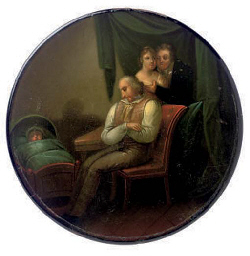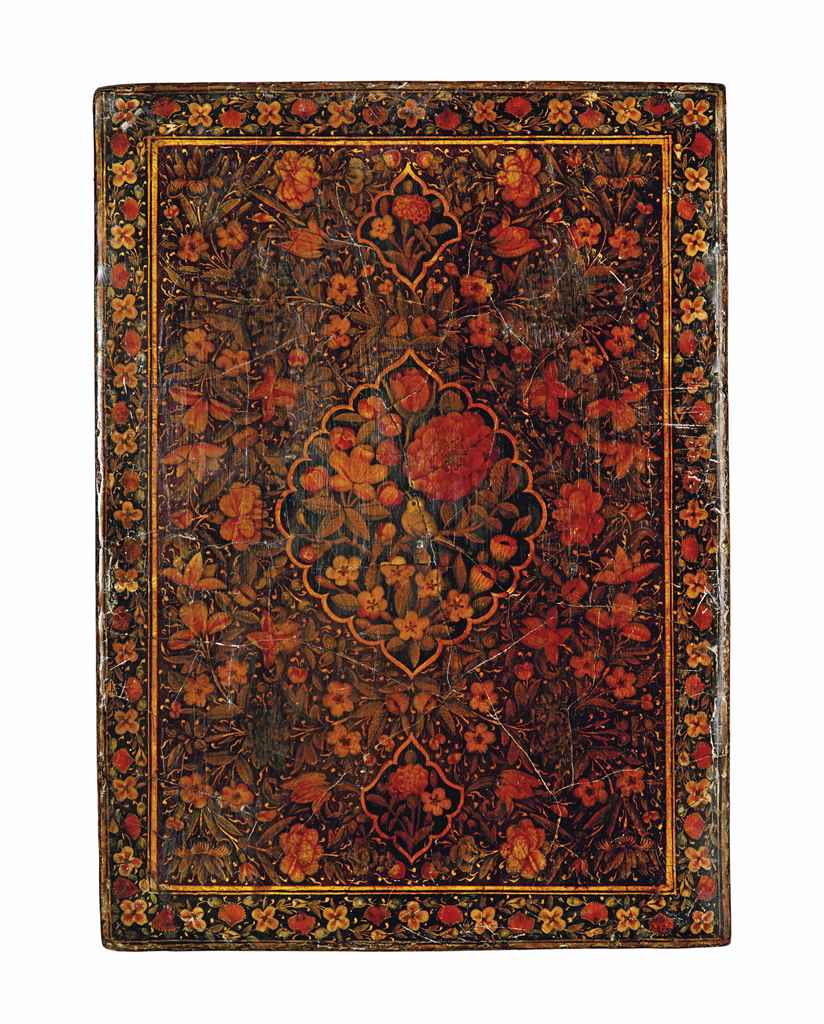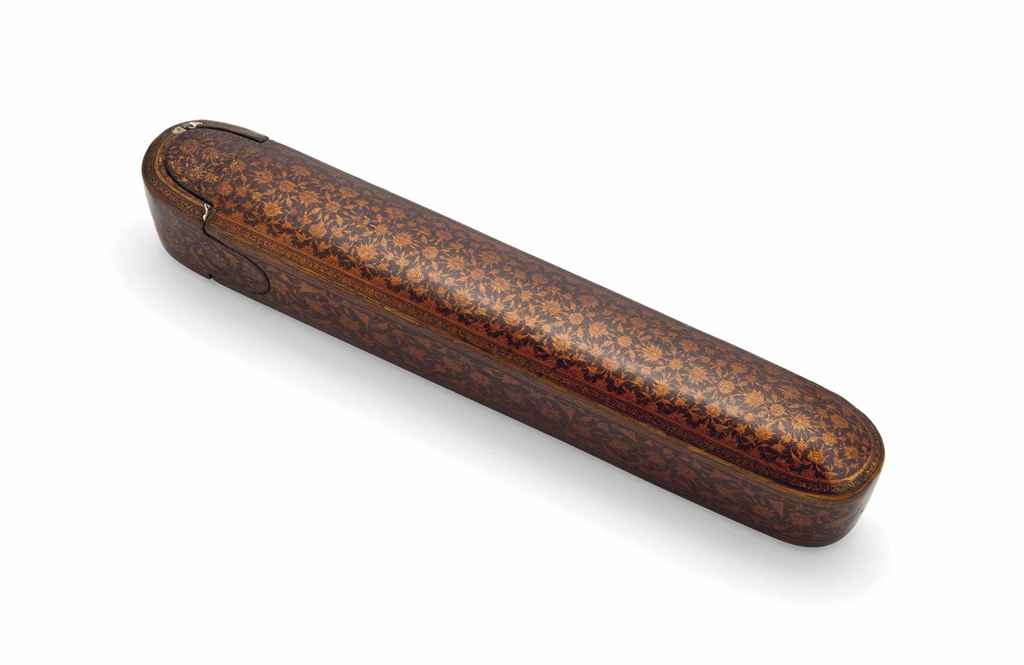*A LACQUERED PAPIER-MÂCHÉ PEN CASE WITH A EUROPEAN LADY'S PORTRAIT (QALAMDAN) PROPERTY FROM AN IMPORTANT EUROPEAN PRIVATE COLLECTION Shiraz, Iran, signed and dated 1302 AH (1885) With rounded ends and sliding tray, polychrome-painted and heightened with gold against brownish-red ground, the top and sides painted with long oval cartouches filled in with a European lady's portrait on the top and two romantic landscape views inspired by Russian prototypes to the sides, the edges and the underside decorated with European-style gilt vegetal meanderings and decorative grids wit typical Qajar lush rose bouquets, the internal tray similar against black ground, with a later dawat (inkwell) to the interior, 21.8cm long. The composition on this pen case is almost identical to another one produced in Shiraz, signed Lutfallah al-Hamzawi and dated 1314 AH (1896-7), now in the Khalili Collection of Islamic Art - LAQ510 (Khalili, Robinson and Stanley, Lacquer of the Islamic Lands: Part 2, London, 1997, p. 230, cat. 456). Iranian models such as ours and the one in the Khalili Collection bear very little from the original Qajar compositions and seem quite clearly indebted to the late 19th-century prototypes produced in Russia for the Iranian market. Indeed the portrait of the European lady on the top is not an individual one, but rather a copy from a well-known composition present on a Russian lacquered pen box (LAQ129), part of the same collection (ibidem, p. 224, cat. 448). By the last quarter of the 19th century, both Russian and Japanese lacquer manufacturers were targeting the Qajar market, attracted by the Iranians' persistent appreciation for this medium (Massumeh Farhad, Mary McWilliams and Simon Rettig, A Collector’s Passion: Ezzat-Malek Soudavar and Persian Lacquer, Washington DC, 2017, p. 35). It wasn't long before the Iranian craftsmen started reproducing the imported models from Lukutin and the Fedoskino factory, making the luxury import goods with European portraits and elongated oval cartouches with Russian romantic landscapes available to a broader local audience, thus closing the great circular journey of Iranian lacquer, which started with the Iranian inspiration of lacquer models in the production of Italy, France, Germany and Russia and lastly came back to Iran at the end of the Qajar epoque.
*A LACQUERED PAPIER-MÂCHÉ PEN CASE WITH A EUROPEAN LADY'S PORTRAIT (QALAMDAN) PROPERTY FROM AN IMPORTANT EUROPEAN PRIVATE COLLECTION Shiraz, Iran, signed and dated 1302 AH (1885) With rounded ends and sliding tray, polychrome-painted and heightened with gold against brownish-red ground, the top and sides painted with long oval cartouches filled in with a European lady's portrait on the top and two romantic landscape views inspired by Russian prototypes to the sides, the edges and the underside decorated with European-style gilt vegetal meanderings and decorative grids wit typical Qajar lush rose bouquets, the internal tray similar against black ground, with a later dawat (inkwell) to the interior, 21.8cm long. The composition on this pen case is almost identical to another one produced in Shiraz, signed Lutfallah al-Hamzawi and dated 1314 AH (1896-7), now in the Khalili Collection of Islamic Art - LAQ510 (Khalili, Robinson and Stanley, Lacquer of the Islamic Lands: Part 2, London, 1997, p. 230, cat. 456). Iranian models such as ours and the one in the Khalili Collection bear very little from the original Qajar compositions and seem quite clearly indebted to the late 19th-century prototypes produced in Russia for the Iranian market. Indeed the portrait of the European lady on the top is not an individual one, but rather a copy from a well-known composition present on a Russian lacquered pen box (LAQ129), part of the same collection (ibidem, p. 224, cat. 448). By the last quarter of the 19th century, both Russian and Japanese lacquer manufacturers were targeting the Qajar market, attracted by the Iranians' persistent appreciation for this medium (Massumeh Farhad, Mary McWilliams and Simon Rettig, A Collector’s Passion: Ezzat-Malek Soudavar and Persian Lacquer, Washington DC, 2017, p. 35). It wasn't long before the Iranian craftsmen started reproducing the imported models from Lukutin and the Fedoskino factory, making the luxury import goods with European portraits and elongated oval cartouches with Russian romantic landscapes available to a broader local audience, thus closing the great circular journey of Iranian lacquer, which started with the Iranian inspiration of lacquer models in the production of Italy, France, Germany and Russia and lastly came back to Iran at the end of the Qajar epoque.

.jpg)
.jpg)

.jpg)








.jpg)
.jpg)
Try LotSearch and its premium features for 7 days - without any costs!
Be notified automatically about new items in upcoming auctions.
Create an alert